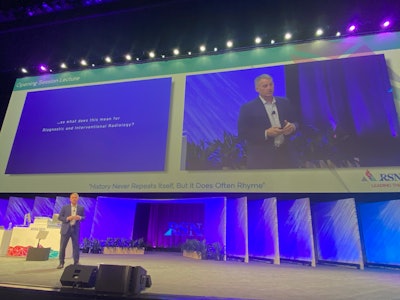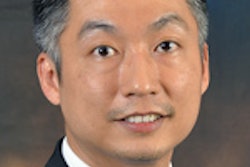CHICAGO -- Radiology leaders merely need to look at history to help embrace new and future innovations, according to a talk given November 26 at the RSNA 2023 annual meeting.
Speaking at the opening plenary session after the president’s address, Howard Chrisman, MD, of Northwestern Memorial HealthCare in Chicago, spoke about how while history does not repeat itself, it does often rhyme when it comes to emerging technologies, taking from a quote attributed to Mark Twain.
“As radiologists, people who are involved in diagnostic imaging, we are well-positioned for this [change],” Chrisman said.
Chrisman used nonradiology examples of how change in society goes through the same cycles of discovery and controversy, including musical tastes, social justice, and transportation. He also explained how the respective impacts of the Spanish Flu and COVID-19 pandemics can be overlayed over each other. In radiology, Chrisman used the example of PACS in its early days.
 Howard Chrisman, MD, from Northwestern Memorial HealthCare talks about how it's important for radiologists to understand how history rhymes when it comes to new innovations, especially as AI continues its surge into radiology clinics.Amerigo Allegretto
Howard Chrisman, MD, from Northwestern Memorial HealthCare talks about how it's important for radiologists to understand how history rhymes when it comes to new innovations, especially as AI continues its surge into radiology clinics.Amerigo Allegretto
“Prior to PACS, we lived in a world where radiology was sort of the center of the ecosystem of the hospital,” he said. “We would bring stacks of films from the film room and do radiology rounds in this brightly fluorescent room. And then along came PACS. We were the first specialty to really be digitized. We really embraced this technology, but it upset the ecosystem of the hospital,” Chrisman continued. “When you think about leading through change, we went from a visible presence to something that is invisible.”
He also used the example of interventional radiology’s beginnings. While Charles Dotter, MD, pioneered this branch of radiology as the “Father of Interventional Radiology,” his work did not catch much mainstream attention in the U.S. It was only when European radiologists drew upon his work to further refine interventional techniques that the greater U.S. radiology field began widely accepting it.
“He was referred to as a mad scientist,” Chrisman said. “Even if we think about the advancements of today…we still have a lot of controversy and cynicism around [interventional radiology’s] appropriate use.”
The same rhyming cycle can be said for AI, he added, saying that while AI will eventually become an everyday staple in clinics, radiologists should embrace the technology as an extension of the expertise radiologists possess.
“We’re really capable of understanding the rhyming nature of the past,” Chrisman said. “How we reflect upon the past will serve us well. It (AI) is an opportunity for us to think differently around who we are.”



















